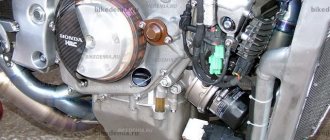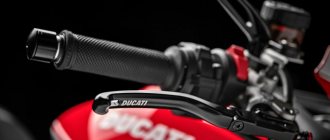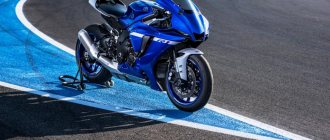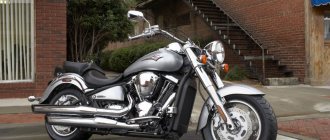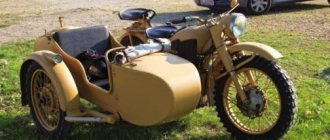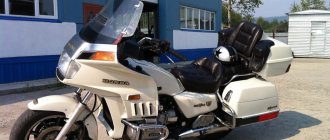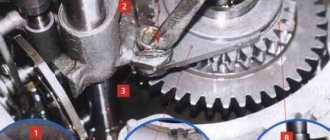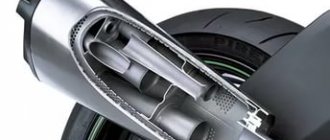There are three main motorcycle factories in the world. In America, the best manufacturer is Harley-Davidson of Wisconsin. This is Hero MotoCorp in India, which is also the largest motorcycle manufacturer in the world. In Europe, the Austrian KTM AG is the largest motorcycle brand. KTM AG sold more motorcycles in 2016 than brands such as BMW, Aprilia and Ducati. KTM AG is also the manufacturer of the X-Bow hypercar. It debuted at the Geneva Motor Show in 2008 and is still in production today.
KTM R100
During World War II, KTM experienced a boom in diesel engine repairs. At the end of World War II, the number of engine repairs dropped almost immediately, which forced Trunkenpolz to think about creating and producing their own motorcycle. Unlike BMW, which was a major supplier to the Third Reich, KTM was not burdened by the same post-war production restrictions. 1951 - Trunkenpolz created a prototype of its first motorcycle called the R100.
This motorcycle uses custom internal components with the exception of Rotax engines from Fitchel & Sachs. Production of the R100 began in 1953, with a team of just 20 employees (including Johann Trunkenpolz himself). They could produce 3 full-fledged motorcycles per day. In the same year, Trunkenpolz began cooperation with businessman Ernst Kronreif. He became the main investor and shareholder of KTM. The company was then renamed Kronreif & Trunkenpolz Mattighofen. Over the next two years, three new products were introduced. R125 Tourist in 1954 and Grand Tourist and Mirabell scooters in 1955.
Brief history
The Austrian company KTM is one of the largest and most famous manufacturers of sports motorcycles in Europe. The official founding date of the company is 1934. It was then that a young but very ambitious engineer named Hans Trunkenpolz, who lived in the city of Mattinghofen, opened a metal processing workshop, which received the difficult name for a Russian person Kraftfahrzeuge Trunkenpolz Mattighofen (KTM).
At first, the young entrepreneur did not succeed in everything, but literally a few years after the start of commercial activity, he began to earn a stable income. And almost 20 years later, already in 1953, Trunkenpolz managed to begin the serial assembly of small motorcycles and mopeds, which were equipped with 2-stroke engines purchased from other developers.
In 1955, successful businessman Ernst Kronreif joined KTM. Ernst Kronreif acquired a controlling stake in the company and became its main shareholder. Of course, after this the company received an updated name, which included the name of the new co-owner. However, this did not affect the abbreviation. It remains the same – KTM (Kronreif & Trunkenpolz Mattighofen).
The reorganized enterprise continued to assemble light motorcycles, and therefore was able to gain a decent share of the Austrian market. The cost of KTM products was more than acceptable, because the motorcycles of this company were excellently bought up by representatives of the middle class, among whom there were always a lot of people interested.
Start of racing and introduction of new models
KTM made its official racing debut in 1954 and won its first title in the 125-entry Austrian National Championship. In 1956 the company competed in the International Six Days Trial, the world's oldest FIM-sanctioned off-road race. She won the gold medal with an outstanding result. In 1957, KTM built its first sports bike, the Trophy 125cc.
This name is undoubtedly associated with winning the Austrian National Championship in the 125cc class just three years earlier. KTM produced in turn the first moped - Mecky - in 1957, Ponny A in 1960, Ponny II in 1962 and Comet in 1963. The Mecky and Ponny I and II became reliable means of urban transportation, while the Kometa became a favorite of off-road drivers. KTM won its first FIM Motocross GP championship in 1974. Then Russian motocross racer Gennady Moiseev won the 250cc class on a KTM 250 motorcycle. This victory was the first of more than 260 world championship titles that KTM won over the next 40 years.
Enduro motorcycle KTM 150 EXC TPI
Enduro motorcycle KTM 150 EXC TPI 2020
The KTM 150 EXC TPI is generally an interesting model: the youngest, but not so much the weakest as the lightest. With proper operation of the gearbox, the 150 will easily buzz into the sunset, outperforming its larger cubic-sized counterparts. At first I thought this was a mean e-mountain bike: it's almost as light, nimble and controllable, and it's hard not to enjoy riding it. And make no mistake about the displacement: this is a very peppy motorcycle, compensating for the small engine with light weight.
KTM 150 EXC TPI 2020
Of course, proper operation of the box is very important here. You will have to switch a lot, but this is how it should be on a small-capacity vehicle, and this does not reduce the pleasure. Like its larger TPI siblings, the KTM 150 EXC TPI engine responds instantly to the throttle. I quickly adapted to the nature of the engine and learned to use gas as efficiently as possible. As with the four-stroke 250, here the rider can get the most out of the bike (with the 450, the limiting factor is usually the rider himself).
Company expansion and subsequent collapse
By 1971, KTM had increased its workforce to 400 and offered 42 different models in its range. KTM also produced motorcycles for racing. In the 1970s and 1980s, the company began producing radiators for several European automobile manufacturers. The radiator business itself generated a significant portion of KTM's revenue during the 1980s. By 1978, the manufacturer had established an American subsidiary, KTM North America, headquartered in Lorain, Ohio, USA. In its native Austria, KTM was renamed KTM Motor-Fahrzeugbau.
In 1981, the company employed 700 people. By 1981, the company's revenue was $750 million. While the profits of the former small car shop in Austria were satisfactory, Japanese manufacturers such as Honda, Yamaha, Suzuki and Kawasaki broke into the international motorcycle market and spread rapidly. It didn't take long for the invasion of Asian brands to dethrone the two-wheeled giants and become the new dominant force in motorcycle manufacturing and sales.
Almost overnight, the success of Japanese motorcycle brands wiped out sales of KTM scooters and mopeds, leading to a production stop in 1988. With the death of then CEO Erich Trankenpolz and the takeover of 51% of the company's resources in 1989, KTM's future was at stake. Taus tried to restore the company's profitability. However, in 1991, several creditor banks took control of KTM.
Enduro motorcycle KTM 250 EXC-F
KTM 250 EXC-F 2020
I'll be honest: I'm a two-stroke guy at heart.
And the four-stroke enduro motorcycles of the KTM EXC-F series became something new for me. With the KTM 250 EXC-F, however, there was a strange sense of recognition: it felt like family. I weigh about 90 kg, and I was curious how she would cope with such a fat man. Answer: better than you expect from her.
Again, the ergonomic body kit helps with handling perfectly, giving an incomparable feeling of unity with the motorcycle and complete understanding.
It was interesting to click the fuel maps from the remote control on the steering wheel. I tried them in all combinations: the first, the first with traction control, the second, and the same with traction control.
KTM 250 EXC-F 2020
I don't know about others (I'm a two-stroke rider), but here the different modes really define the different character of the bike, and I quickly found out where it could be useful. For example, on dusty uphill turns without traction control, I probably would have gotten out of the way, I was too bad at going into them. But by turning on the traction right before the turn, I passed it without losing time and without much risk.
Big four-strokes have a locomotive pull from the bottom end, but the 250 EXC-F needs to be revved up, and it wakes up from mid-range and above. The gearbox also needs work, but it drives better than I expected from it, and for me it literally lacks a little power. For me, this is just the kind of bike that you can ride safely without fear.
The 1994 Duke sports bike ushered in a new era for KTM
The product range that KTM cultivated in the 1970s and 1980s was split into four separate divisions in 1992. The motorcycles were manufactured by KTM Fahrrad GmbH. Car radiators from KTM Kühler GmbH, production of tools was transferred to KTM Werkzeugbau GmbH. And the motorcycle division that provided KTM with its early successes was called KTM Sportmotorcycle Gmbh.
KTM Sportmotorcycle GmbH started off slowly, but in the following years it successfully increased production and turnover. With the new owner KTM Motorradholding GmbH (a joint venture between Cross Holding and others), KTM Sportmotorcycle took over the position and was able to take over the tools division of KTM Werkzeugbau GmbH. KTM Sportmotorcycle has invested more in production and completely new R&D facilities. This led to new innovations and the creation of more products. The company once again returned to its interests related to sports.
KTM has sponsored and competed in many officially sanctioned motorcycle racing events. The Duke sports bike was launched in 1994 and became the company's most popular standard model. In 1996, KTM debuted its now iconic orange color scheme. And in 1997, four-cylinder liquid-cooled Supermoto and Adventure motorcycles debuted. In 1995, KTM acquired the Swedish company Husaberg AB. And in 2013, it acquired another Swedish competitor, Husqvarna. By 2015, KTM had become the largest motorcycle manufacturer in Europe. Revenues for the year were €1 billion (US$1,128,149,000) and the company joined three of the four divisions that were introduced after the 1992 split.
60s
The systematic development of the enterprise continued until the end of the 60s. But the course of history was changed by the company’s specialists developing their own engine. It was then that the essence of Kronreif & Trunkenpolz Mattighofen's existence ceased to be reduced to assembling motorcycles from parts produced by other developers. Moreover, almost immediately, several debut models of the company were presented simultaneously, among which the off-road version, as well as a powerful sports bike, especially stood out.
KTM at Dakar Rally 2021
KTM currently holds 96 MXGP, MX1 and MX2 world championships since 1974 and 114 E1, E2, E3 and Super Enduro championships since 1990. The company has won 260 championships and 3 consecutive championships in AMA Supercross from 2015 to 2021. KTM debuted at the Dakar Rally in 1994 and finished 2nd to 12th in the race in 1998. Between 2001 and 2021, no other manufacturer has dominated the Deadliest Rally Race like KTM. Other rallies that KTM has competed in are the Atlas Rally and the Maroc Rally. The company has 37 titles in the world of rally racing and is a 15-time winner of the FIM World Rally Championship.
In 2003, KTM entered road racing, especially in the 125 and 250 cc classes. KTM won the 2005 Constructors' Championship Grand Prix and the 2012 Moto3 Manufacturers' Championship. This was followed by manufacturer titles in 2014 and 2021 and, in the same year, the Moto 3 World Championship title. KTM also competes in the MotoGP and Moto2 classes and was an active participant in the German International Superbike Championship from 2009-201.
2021 KTM X-Bow Race Cars
In 2008, KTM entered the world of hypercars with the X-Bow. The X-Bow is an ultra-light sports car with a mid/rear engine and rear wheel drive. It is intended for street and race track use (except in North America, where it can only be purchased as a race car). The carbon fiber construction allows the X-Bow to weigh just over 1,700 pounds, a fraction of the weight of a passenger car.
The current version uses Audi's 2.5-liter turbocharged engine, producing between 295 and 346 horsepower. It is equipped with a standard VIA 6-speed manual transmission or an efficient 6-speed sequential manual transmission. Gears with double output automatic transmission. Top speed 150 mph. At professional level, the X-Bow won the 2009 British GT Supersport Championship GT4 class in the 2011 season. And the 2021 GTS GT World Challenge Championship, sanctioned by USAC.
Enduro motorcycle KTM 300 EXC TPI
KTM 300 EXC TPI 2020
The first thing I want to note about the best-selling enduro model, the KTM 300 EXC TPI, is that I have virtually no knowledge of fuel-injected motorcycles. My personal 300 is a carb, and I've been racing carbs for almost my entire career, so I was curious as hell.
The first thing I noticed was how fast the gas works. In every sense: firstly, the throttle handle moves very easily, and secondly, how well the engine responds to the handle.
On my carburetor motorcycle, the gas works with a delay: the throttle is opened by a cable, the carburetor reacts to the changed patency, the petal valves open, and all this takes time. TPI does not require all this and works instantly.
KTM 300 EXC TPI 2020
It took some getting used to, but once I got used to it, I realized it was great. That is, you see a bump or a hole and want to lift the wheel over it - and on my carb motorcycle this requires some effort, but the 300 with TPI responds to the handle more clearly and willingly lifts the wheel over obstacles. At first I overdid the throttle a few times, but then, as I said, I got used to it and really enjoyed the suppleness.
KTM says the 2021 models have improved fuel delivery, traction smoothness and throttle precision thanks to an additional air pressure sensor, as well as a new throttle body that, in simple terms, is located as close to the engine as possible and operates more accurately.
I’ll also note that their new seats are something! The most non-slip seats I've ever sat on. Another nice feature is the new tail, which fits comfortably between your legs when going down steep slopes.
There is also a disadvantage to the tail: when I put my right hand under the rear fender, I did not find any handles there for dragging the rear of the motorcycle. Although it was before.
I had a nice ride on the KTM 300 EXC TPI, trying different surfaces and different things: fast stuff, extreme stuff and forest riding. And the suspension on the 300, it seemed to me, was weaker than on the 500, although quite decent.
The more I rode it, the more I thought about the future of off-road motorcycles. If the injector gives such a response, why do we need carbs?
Range of characteristics
The company specializes in producing high-performance motorcycles for on-road, off-road and racing applications. The range of off-road bikes is divided into four categories: motocross, cross-country, enduro and freeride. Motocross bikes are SX 105, 126, 150 and 250cc models. cm (50, 65 and 85 – youth) and KTM SX-F. Cross-Country XC motorcycles include 150cc, 250cc and 300cc two-stroke models. cm and four-stroke models with a volume of 250, 350 and 450 cc. cm.
The Endure EXC range includes 250cc, 350cc, 450cc and 510cc four-stroke motorcycles. cm, as well as the Endure R with a 690 cc engine. see The Free Ride series includes the Freeride 250R and the all-electric Freeride E-SX. Street versions XC and E-SM. They are available on the European market. KTM's line of street bikes is based on the original Duke 620 from 1994.
These motorcycles are divided into six categories: Supermoto (690 SMC R, 625 SMC and 560 SMR), Adventure Tourers (1090 Adventure and 2190 Super Adventure), Sports Tourer (1290 Superduke GT), Naked Bikes (standard Duke and Superduke versions), Supersport (racing motorcycle RC 390 and RC16). And a recently discontinued superbike consisting of the homologated 1190 RC8 street/race bike.
Expansion of production
In 1934, Hans Trankenpolz founded a repair shop in Mattighofen, Austria. Three years later, he became desperate to sell DKW motorcycles, and then expanded his workshop, which stood as one of the largest auto and motorcycle workshops in the country. In 1951 the company began developing its own motorcycle, and two years later the production series of the KTM R 100 was launched. The company, officially known as Kronreif, Trankenpolz, Mattighofen, immediately began racing and the first successes began to appear. Erwin Lechner was one of the riders who enjoyed his victory in 1960, racing a KTM motorcycle with an engine designed by engineer Ludwig Apfelbeck. KTM entered the US market with the 125cc Motocross motorcycle in 1968.
Soon information about won foreign races began to circulate in Europe. Highlights of the seventies included the powerful 50cc models and the first world motocross title won on a KTM in 1974 by Russian rider Gennady Moiseev in the 250cc class. Riders Heinz Kinigadner and Trampas Parker laid the foundations for a modern KTM legend, winning three world championships in the next decade. In 1984, KTM began developing a liquid-cooled four-stroke motorcycle. Thus starting mass production of the first LC4 engine in 1987 – a concept that has become a KTM success story over the decades.
Enduro motorcycle KTM 450 EXC-F
Enduro motorcycle KTM 450 EXC-F 2020
If the KTM 500 EXC-F is deceptively intimidating, the KTM 450 EXC-F is a more honest model. It's a little lighter, a little sportier and a little more provocative. It gets to top speed with the same ease as the 500cc model, and you can also take your time with it, staying in one gear and getting great traction at any time.
KTM 450 EXC-F 2020
What's also good about it is how the new chassis works. Big bikes like this were once heavy, but that's not the case here. This is a light, maneuverable motorcycle with excellent brakes that will show themselves exactly at the moment when it is necessary (for example, in sharp turns, when you urgently need to curb all the inertia of a large motorcycle - and the brakes will do this with ease, and the front suspension will perfectly handle this braking). The even larger 2021 four-stroke models are equipped with a cooling fan, which is good: it was hot on the test ride and they came on periodically.
Bankruptcy
The industry fell on hard times in the late 1980s. KTM Motorfahrzeugbau AG was no exception and suffered greatly. As a result, KTM Motorfahrzeugbau AG was declared bankrupt in 1991. A year later, the newly created KTM Motorcycle Division KTM Sportmotorcycle GmbH opened under new management with a new Hard Enduro concept and a new design. In 1994, it introduced the first DUKE, and just a year later acquired WP Suspension and sports bike manufacturer HUSABERG.
Shane King 1 The 500cc World Motocross Championship and many other victories have revived the sporting heritage of the long-standing brand. KTM. In 1999 the company moved to a newly built plant in Mattighofen.
KTM motorcycle series
Series 125 Euro
This series consists of two machines: the dual-purpose 125EXE and the urban enduro 125 Supermoto. They differ from each other mainly in their wheels, covered in universal tires (125EXE) and road tires (125 Supermoto). Both motorcycles are equipped with a new two-stroke engine, unified in design with sports power units. The frame is tubular, welded, made of chrome-molybdenum steel. Telescopic front fork - inverted type. The rear suspension of the PDS (Progressive Damping System), as on all “adult” KTMs, provides progressive characteristics without an intermediate linkage mechanism only due to the design of the shock absorber itself.
EXC Enduro Series
Motorcycles for enduro competitions are as close in design as possible to cross-country motorcycles. They are equipped with a wide range of two-stroke engines (models 125EXC, 200EXC, 250EXC, 300EXC and 380EXC), including the new 250 cc engine. New generation four-stroke engines are used on the 400EXC Racing and 520EXC Racing motorcycles.
The company is also developing a two-cylinder V-shaped four-stroke 1000 cc engine, the LC8. This power unit is designed to power both the high-performance rally bike and the upcoming road-going Super Duke. The debut of the new product will take place in the fall of 2000.
LC4 Hard Enduro Series
The company's parade horse is the famous 640 Duke II. This is an urban enduro style motorcycle with 17-inch alloy wheels. The futuristic half-fairing with two headlights located one above the other looks peculiar. The 640 cc engine is equipped with an electric starter.
The dual-purpose motorcycles 400LC4-E Hard Enduro and 640LC4-E Hard Enduro, unlike many of their classmates, truly have excellent off-road qualities. Both cars are equipped with a four-stroke engine with electric start, two-person saddles and passenger footpegs. The 640 cc modification is also available as the urban enduro 640LC4-E Supermoto.
The 620LC4 SC (Supercompetition) variant is closer to purely sports models. It is made as a single-seater, the engine does not have an electric starter. The tires have an off-road tread pattern. However, the presence of a full set of lighting equipment made it possible to certify this car for driving on regular roads. It is also available in the 620LC4 SC Super-moto variant.
For serious off-road raids, the 640LC4 Adventure-R is equipped with a 640 cc engine with electric start, a Paris-Dakar-style fairing with two headlights, a 30-liter gas tank and a robust rear luggage rack.
Mini 2000 series
In collaboration with the Italian company Lem, KTM produces a wide range of children's cross-country motorcycles. The 50 Mini Adventure is designed for the youngest athletes, aged 4 to 6 years. It is equipped with a single-cylinder, two-stroke, air-cooled engine with an automatic centrifugal clutch and no gearbox. The 50SX Junior modification is distinguished by a faster engine and increased suspension travel. The engine of the 50SX Senior motorcycle, designed for athletes aged 7 to 9 years, has been boosted even more.
At a higher level of technical perfection is a motorcycle with the 60/65SX index. It is equipped with a two-stroke liquid-cooled engine (available in 60 or 65 cc versions) mounted in a chrome-molybdenum steel frame. The car has a six-speed gearbox, disc brakes on both wheels and is intended for 9-11 year old athletes.
SX Motocross Series
The 125SX, 250SX and 380SX motorcycles are equipped with single-cylinder, two-stroke power units. For the 2000 season, the 250 cc version of the engine received a new cylinder, cylinder head and crank group. Compared to last year's version, the size of the motor has changed (66.4x72 mm instead of 67.5x69.5 mm).
The new four-stroke engine is also installed on the 400SX Racing and 520SX Racing motorcycles. It's an exceptionally light and compact unit - narrower than a 250cc two-stroke. In the cross version, the engine is coupled with a four-speed gearbox.
The first purebred street bikes: 990 SUPER DUKE and 950 SUPERMOTO
The first “Made in Austria” superbike was launched in 2008 – the attractive 1190 RC8. Mattighofen's team competed the following year in the German International Superbike Championship (IDM). He finished second in his first season. Over the years, the orange racing strategy has grown. While KTM continues to dominate international enduro, motocross and rally competition, it is also stepping up its efforts in the important American Supercross competition. He began to celebrate significant successes and championships in no time.
2015 improved on previous achievements with Ryan Dungey winning the first Austrian manufacturer's Supercross title. His victory in the US Motocross Championship was a double success. Also worth mentioning is the appearance in 2012 of the newly established Moto3 World Championship with a racing bike entirely “made in Austria”. Sandro Cortese won the title for the first time, which was successfully defended in 2013, another milestone in KTM history.
In 2021, KTM CEO Stefan Pierer announces that KTM will enter the MotoGP class. All the international experience accumulated in many racing series is constantly being introduced into series production and is constantly being developed. The team has the opportunity to present the most important products and innovations every year. Whether on asphalt or off-road, KTM has positioned itself as a global brand with an impeccable product range, ranging from 50 to 1300 cc in 2015.
Models such as the hugely successful naked DUKE 125, 200 and 390 as well as the RC 125, 200 and 390 also inspire young riders. Cutting-edge solutions such as the 1190 ADVENTURE (2013), equipped with the MSC motorcycle stability control system developed jointly with BOSCH, and the 1290 SUPER DUKE R (2014) underline the desire to be a trendsetter even in high segments. For the 2015 model year, KTM is expanding its ADVENTURE lineup. 1050 ADVENTURE and the fully equipped 1290 SUPER ADVENTURE.
We bring to your attention a brief history of the legend, the KTM Brand. Key dates and events. An interesting, long path... from success and championship in world championships to... bankruptcy. And back to success! 1934 Hans Trunkenpolz opens a workshop in Mattinghofen.
Mattighofen (German: Mattighofen) is a city in Austria, in the federal state of Upper Austria. It is part of the district of Braunau am Inn. The population is 5357 people (as of December 31, 2005). Covers an area of 5 km². Marked on the map with the letter A in a red balloon.
1937 Trunkenpolz becomes the official distributor of DKW motorcycles.
1938 Trunkenpolz grows rapidly and becomes the largest motorcycle and car repair shop in Upper Austria.
1951 Main Beginning: release of the first light KTM motorcycle with a 98 cm3 engine (model R 100).
1953 Start of serial production of KTM motorcycles (a team of 20 people assembles 3 motorcycles per day). First participation in racing (Fifth Gaisberg competition: KTM takes three first places!). Businessman and racing enthusiast Ernst Kronreif buys a stake in KTM. Now the company is officially called “Kronreif, Trunkenpolz, Mattighofen”.
1955 Launch of the KTM Tourist model (125 cm3); first road competition.
1956 Debut in the international Six Days competition; Egon Dornauer takes gold.
1957 Expansion of the range – a sports motorcycle (Trophy 125 cm3) and the first scooter (Mirabell).
1958 Erwin Lechner continues its winning streak in off-road racing with a new KTM motorcycle model built by engineer Ludwig Apfelbeck.
1959 The production of motorcycles is suspended as a result of the crisis in the motorcycle industry. However, the first scooter “Ponny” from KTM is released.
1960 Ernst Kronreif passes away, and two years later Hans Trunkenpolz dies of a heart attack. The company is again renamed Krafträder Trunkenpolz Mattighofen, and Hans' son Erich Trunkenpolz takes over management.
1963 The range of models grows, the new Comet model appears.
1964 Began production of bicycles. Country cross participation has resumed. The first KTM factory team to compete in the Six Days is born.
1966 Release of the 10,000th Comet. KTM wins three gold medals at the Six Days in Sweden.
1968 Penton Six Days cross-country model produced for export to the USA.
1970 Launch of the first KTM engine. Manfred Klerr wins the Austrian national competition with the new 250 cc Motocross bike.
1971 KTM's staff reaches 400 people.
1973 Serial production of 250cc (Cross & Endure). First points in world competitions and victories in the Grand Prix for KTM (P. Rulev and G. Moiseev).
1974 The KTM product line consists of 42 different models. Start of serial production of KTM Hobby III. Gennady Moiseev wins the motocross world championship in the 250 cm3 class on KTM.
1975 Presentation of the Comet Grand Prix 125 RS. Full-time KTM rider Sigi Lerner wins the Austrian Motocross Championship. Alessandro Gritti wins the European Enduro Championship. Gennady Moiseev wins the World Motocross Championship for the second time in the 250 cm3 class.
1976 Creation of our own 125cc engine. The success of the Italian racing team Farioli racing team (on KTM motorcycles).
1978 KTM America is founded, located in Lorain, Ohio; first representation in the states. Line extension 50cm3. Gennady Moiseev takes first place at the KTM Motocross World Championship for the third time.
1980 Change of company name to “KTM Motor-Fahrzeugbau KTM”. Strengthening the direction of development of sports models (weight reduction, improved handling).
1981 Launch of the first 125cc water-cooled motocross motorcycle. The company has a staff of 700 people. Annual income amounted to 750 million Austrian schillings (about 75 million dollars). 76% of products are exported to 13 countries.
1982 Cross models are equipped with a new “Pro Lever” rear wheel suspension. Development and launch of a 4-stroke water-cooled engine.
1984 Production of KTM radiators began. The first order of the Austrian Army. Heinz Kinigadner wins the World Motocross Championship in the 250cc class.
1985 Production of the 100,000th KTM engine (500cc, water cooled). Heinz Kinigadner wins the 250cc World Motocross Championship for the second time
1986 KTM is the first motorcycle manufacturer to offer front and rear disc brakes. KTM wins in every category at the Six Days in Italy.
1987 Start of mass production of a new engine (4 strokes, 1 cylinder, 560 cm3, overhead camshaft). 98,000 radiators, 93,700 bicycles, 12,600 mopeds and 10,600 motorcycles were produced.
1988 Production of mopeds ceased.
1989 KTM and Trampas Parker (USA) win the World Championship in the 125cc class, as well as in the sidecar class with the Huesser pair (Christoph Huesser / Andreas Huesser). KTM sells a controlling stake in GIT Trust Holding. The manager and inspirer of the company Erich Trunkenpolz passes away.
1991 KTM Motorfahrzeugbau AG declares bankruptcy; The company is divided among successors in the areas of radiators, motorcycles, bicycles and tool production.
1992 The newly formed motorcycle division, KTM Sportmotorcycle GmbH, opens under new management, with a new Hard Enduro concept and new motorcycle designs.
1993 KTM enters the world of Rally (wins in Atlas Rally in 5 categories).
1994 KTM Sportmotorcycle GmbH renamed KTM-Sportmotorcycle AG. The company has a staff of 212. The company produces the Duke series road bike.
1995 Acquisition of Swedish Husaberg AB and acquisition of a controlling stake in White Power Suspension. Production of 12,000 motorcycles, the company's revenue was 1.1 billion Swedish shillings. 2 Enduro World Championship titles, victories in Master Rally and Tunisia Rally.
1996 Start of production of the LC4 engine with electric starter. Opening of representative offices in Germany and Switzerland. The shares of KTM-Motorradholding AG are listed on the Vienna Stock Exchange. World Motocross Championship title with Shayne King, numerous victories in enduro and rally competitions.
1997 Presentation of the road-going LC4 Supermoto, as well as the LC4 Adventure, the first “cruising” bike. Three World Enduro Championship titles: Shane Watts (125), Mario Rinaldi (400) and Kari Tiainen (500).
1998 PDS (Linkless Suspension System) on two-stroke models, new generation of 125/200cc engines, New Z design. Construction of a new production facility with a new R&D (research) center. Opening of a branch in England.
1999 KTM production was established at new production facilities. Release of a new four-stroke engine with a separate lubrication system 125/200 cm3. Opening of the KTM Spain representative office. Leaving the stock exchange. Continuation of the winning streak: Enduro World Championship Juha Salminen (125 cm3), absolute champion of the Enduro World Championship (Giovanni Sala). Thierry Magnaldi wins the new Rally World Cup race.
2000 Presentation of Intermot Munich two-cylinder engines. Opening of the KTM France representative office. An incredible year of victories for KTM: 6 world championships! 125cc Motocross World Champion (Grant Langston), 500cc Motocross World Champion (Joel Smets), 125cc Enduro World Champion (Juha Salminen), 250 4T Enduro World Champion (Matteo Rubin), 400cc Enduro World Champion (Mario Rinaldi), 500cc Enduro World Champion (Kari Tiainen).
2001 Moves the components warehouse to the Mattinghofen warehouse. Juha Salminen Enduro World Championship title and James Dobb 125cc World Motocross Championship championship.
2002 Start of new engine production in Munderfing. Championship in the Super Moto World Championship Therry van den Bosch. Victory in the Dakar Rally Fabrizio Meoni on the new 950 Rally. Juha Salminen once again takes the lead at the Enduro World Championships. [KTM riders win every stage of the Dakar race. Alfie Cox wins two stages and finishes second to Fabrizio Meoni.]
2003 Sales of the 950 Adventure model begin. Presentation 990 Duke New research center in Mattinghofen. 70,514 motorcycles sold. Total income amounted to 376 million Euros. KTM competes in the Moto GP Road Racing World Championship, 125cc. World champions 2003: Juha Salminen (Enduro), Steve Ramon (125 MX), Joel Smets (650 MX). Cyril Despres wins the World Rally Cup. Victories in US national competitions 2003: Grant Langston (125 Supercross), Mike Lafferty (Enduro).
[KTM riders continue to win every stage of the Dakar Rally. Alfie Cox leads the first 7 stages, but retires due to a crash on stage 8.]
2004 Launch of the 990 Super Duke, presentation of the 990 RC8 Venom and 950 Supermoto at INTERMOT in Munich. Construction of a new administrative premises in Mattinghofen. Successful placement of bonds on investment markets.
Start of construction of two new representative offices in Hungary and Slovakia. Worldwide sales amounted to 76,815, the company's revenue was 402.4 million Euros. 17 victories at world championships, a total of 104 titles.
2005 Launch of sales of the 950 Supermoto model. Presentation of the 990 Adventure and the 950 Super Enduro R. Cooperation with Polaris Industries Inc. Worldwide sales of 80,356 motorcycles, annual revenue of 451.2 million Euros. 16 victories in world championships, a total of 120 titles. KTM wins the Constructors' Championship in the 125cc Road Racing World Championship. Victories in all six world enduro championships go to KTM! Cyril Despres wins Dakar.
2006 KTM riders win all stages of the Dakar Rally. Marc Coma takes first place, with the top eight positions all occupied by KTM riders. Business year 05/06 – for the first time the company's turnover exceeds 500 million euros. Sales totaled 84,421 motorcycles. These results were facilitated by the successful presentations and launch of new off-road models in the line (990 Adventure, 950 Super Enduro), and the 950 Supermoto model in the two-cylinder engine segment. 9 world championship titles, 7 constructors' championships, a total of 136 world championship trophies.
2007 The overwhelmingly positive response to the world premiere of the KTM X-Bow at the International Motor Show in Geneva strikes a balance: The Upper Austrian company launches a lightweight sports car into series production.
2008 A new high-tech logistics and spare parts center for KTM allows increasing the speed of delivery of components to the KTM world. This year is shaping up to be another successful year in racing. The KTM factory team wins nine individual championships and takes seven constructors' championships in world competitions. Total 162 cups for the year!
2009 At the EICMA show in Milan, KTM unveiled the revolutionary 350cc MX motocross model, along with two eye-catching 125cc concepts that brought cheers beyond the main stage. The official racers are once again delivering more than satisfactory results. Motocross and enduro teams take 4 out of 6 possible wins at the world championships. The first KTM Superbike becomes vice champion at the IDM (German national championship) races. The company of motorcycle enthusiasts earns 173 World Cup titles.
2010 KTM does the impossible and takes home ALL the World Motocross Championship titles. Antonio Cairoli wins the MX1 class with the revolutionary 350 SX-F. Marvin Musquin leads the MX2 class and Steffi Laier takes first place in the WMX class. Successful global launch of the much awaited 125 Duke.
Presentation of new models 990 SMR and SMT.
2011 Marc Coma wins the motorcycle class in the Dakar Rally for the first time on a KTM 450 Rally, his third victory and 10th for KTM. World premiere of Duke 690 4 and Duke 200 at EICMA.
2012 Cyril Despres again wins the motorcycle class in the Dakar Rally on the KTM 450 Rally. 11th victory for KTM and 4th for Despres. The European Junior Cup starts (EJC – European Junior Cup).
Sandro Cortese wins the Moto 3 World Championship on KTM. Announcement of the Duke 690 R and Duke 390 at EICMA.
Presentation of the KTM Adventure 1190 (INTERMOT 12/12)
2013 KTM starts from the top with strong teams in the Dakar Rally, Rally South Africa, Darryl Curtis and Riaan van Niekerk from the KTM 'B' team. In Santiago on January 19, Cyril Despres finished the Dakar race for the fifth time. Five first places in the race.
KTM will present the new 1290 Super Duke again at EICMA in early November.
Prepared using the Internet,
KTM has set a new standard in the enduro segment
In terms of new technologies, especially in the field of electric mobility, KTM is taking a leading role in the development of new products and is introducing two electric off-road bikes. FREERIDE E-XC and E-SX. In 2015, E-SM, KTM's electric solution for road use, joined this group. With continued strength in the SUV segment and an ever-expanding street range, the former motorcycle workshop is now an economically healthy, highly motivated and leading European motorcycle manufacturer. KTM has been following its strategy since the takeover of the Husqvarna brand in 2013. Despite all the successes, KTM is still looking to the future. KTM CEO Stefan Pierer's vision is: "KTM intends to become the world's leading sports motorcycle manufacturer."
Post Views: 1,203
Enduro motorcycle KTM 500 EXC-F
Enduro motorcycle KTM 500 EXC-F 2020
Jumping into a big 500 first thing in the morning may seem a bit presumptuous, but for me it's a way to get to know the track without having to worry too much about riding technique. Having warmed up in a 30-minute ride, I was ready for a detailed acquaintance with other models.
The first impression of the motorcycle seemed very pleasant. I immediately felt the quality of the non-slip seat upholstery and the softness of its foam filling, felt how well thought out the body kit was and what a great feeling of the motorcycle it gives in the rack, appreciated the work of the box, and generally formed an impression of the new models.
KTM 500 EXC-F 2020
This impression stayed with me all day, even when I gave up the 500 and drove the track again and again in each of the other 7 models. And although the motorcycles in the series are quite different, from the 150 TPI to the big 500, they are all similar in many ways and form a series not only by name, but also by the sensations of riding them. By the way, I still haven’t gotten used to their height of the footpegs and the length of the gearbox foot - if I bought one of them, the first thing I would do is change it.
The KTM 500 EXC-F has a deceptively mean look, but I didn't find it all that scary. Just a good fun bike that pulls and pulls until it hits the speed limit. And you don't have to drive at maximum speed to have fun - you can just stick it in third gear and ride it all day, letting it purr quietly at the bottom and burst out when you open the gas.
